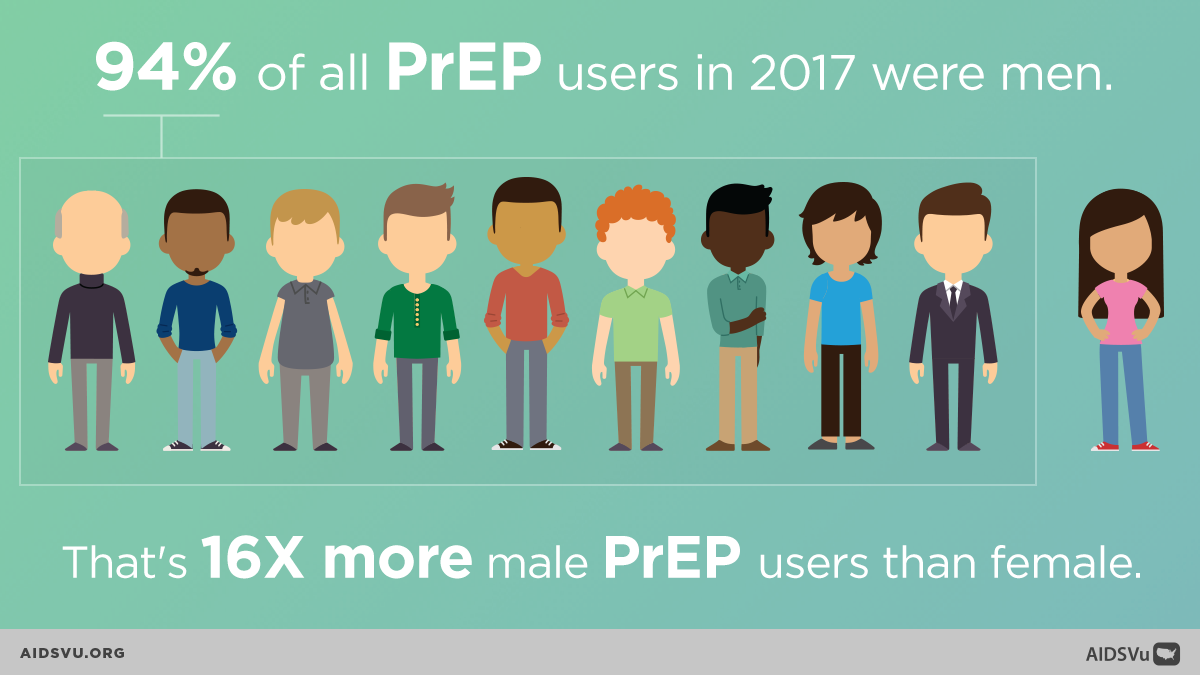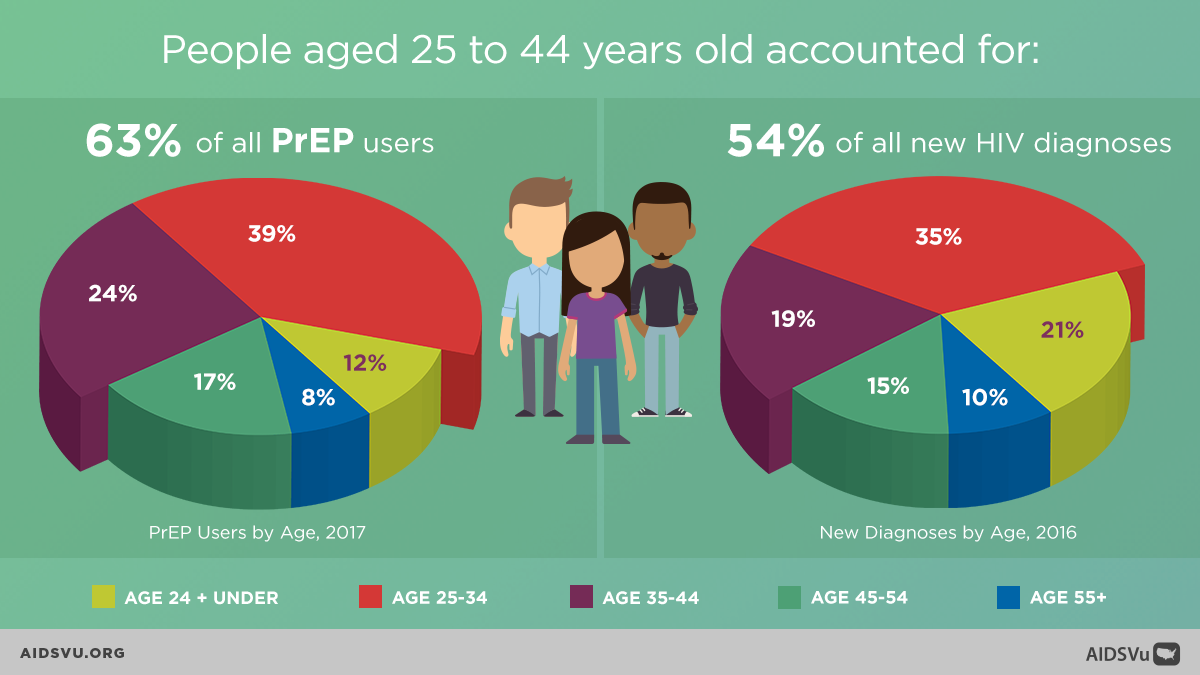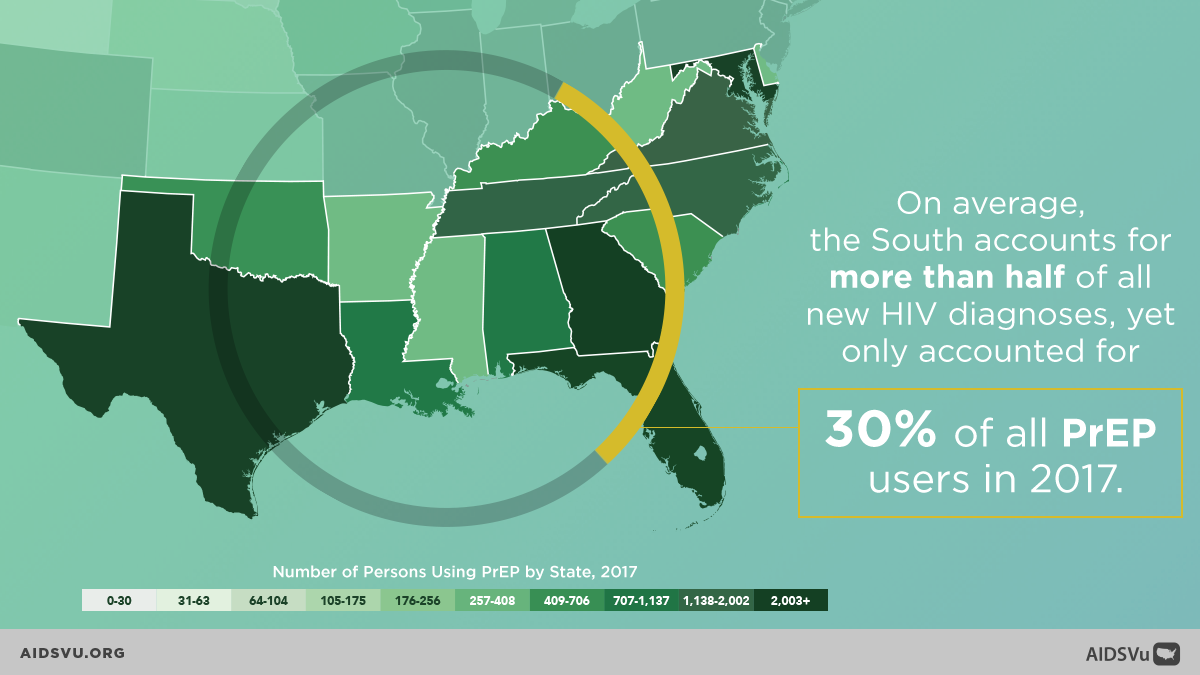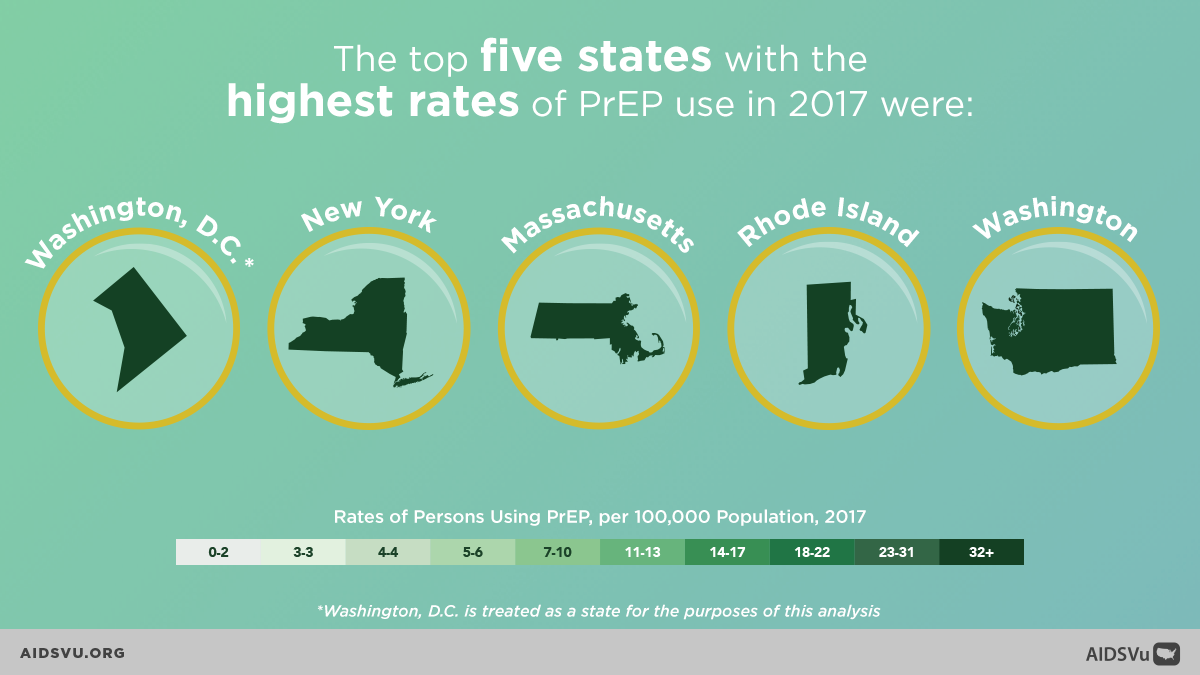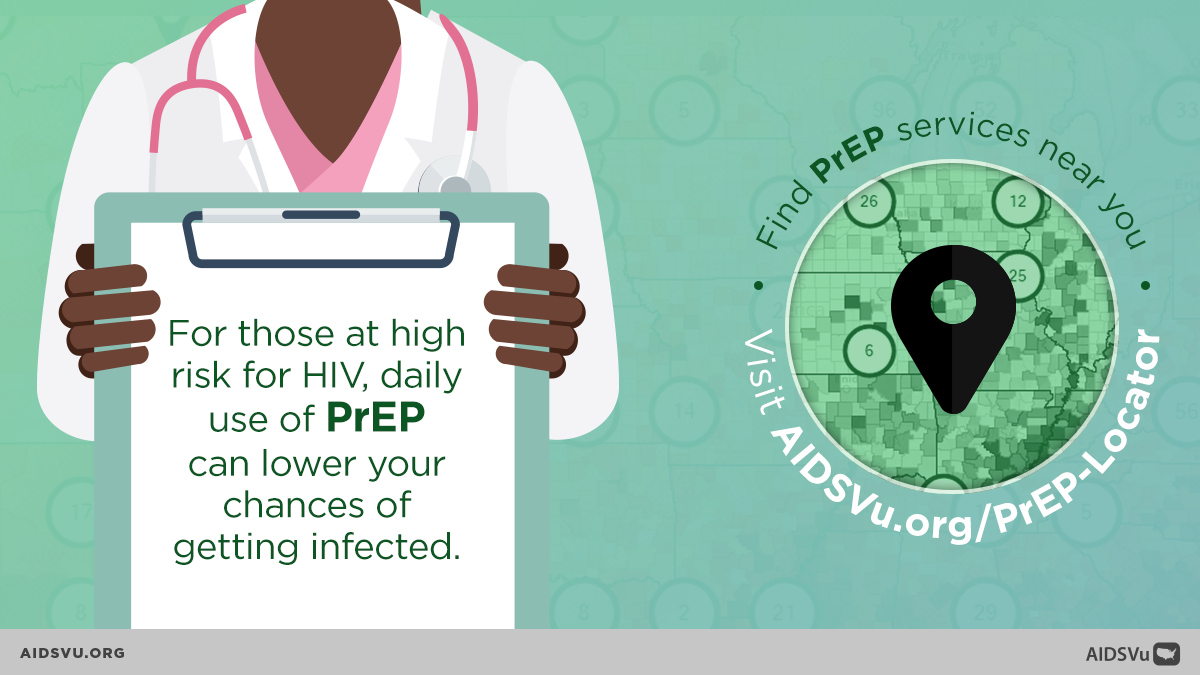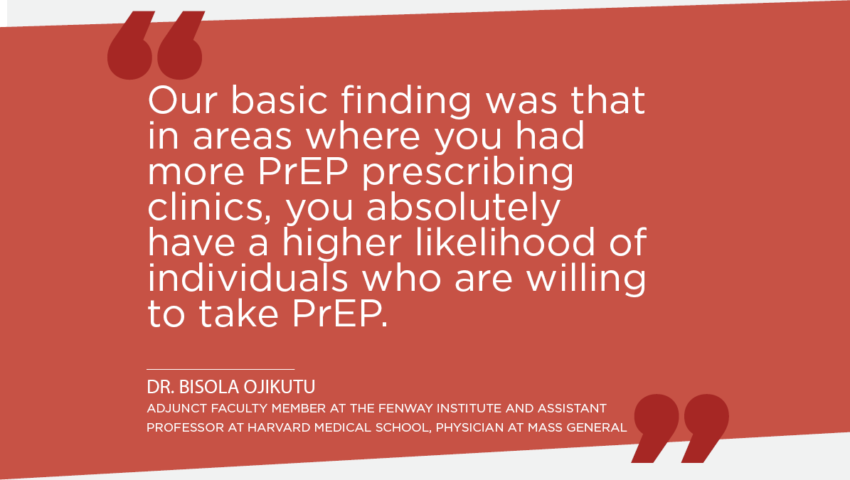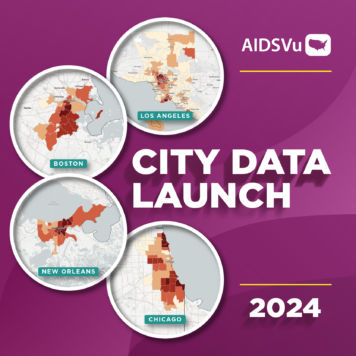Today, AIDSVu is excited to share new data and interactive state-level maps visualizing PrEP use in 2017, showing a 56% average annual increase in PrEP use across the U.S. from 2012 to 2017 — including a nearly 30% increase from 2016 to 2017. Earlier this year, AIDSVu released the first-ever interactive state-level data and maps visualizing PrEP use from 2012 to 2016. The PrEP data on AIDSVu represent a conservative, or minimum, number of PrEP users in the U.S. by year, and can be stratified by age and sex.
PrEP, or pre-exposure prophylaxis, is when people at risk for HIV take HIV medicine daily to lower their chances of getting infected with HIV. The Centers for Disease Control and Prevention (CDC) has estimated that approximately 1.1 million people are at high-risk for HIV exposure and could benefit from comprehensive HIV prevention strategies, including PrEP.
While the PrEP data on AIDSVu reveal significant increases in PrEP use year over year from 2012 to 2017, they also highlight important disparities across different sexes, age groups, and geographic regions. For example, there were 16 times more male PrEP users than female PrEP users in 2017, and while the Southern U.S. accounted for more than half (52%) of all new HIV diagnoses in 2016, the South only represented 30% of all PrEP users in 2017. The ratio of PrEP users in 2017 to the number of people newly diagnosed with HIV in 2016—referred to as the PrEP-to-Need ratio (PnR)—was less than a third for women (0.8) than for men (2.9), and lowest in the South (1.5) compared to any other region, indicating an inequity in PrEP use relative to need.
“It is said that things that are not measured do not change. Public health decision-makers rely on reliable, consistent data to help them determine where they are making progress and where there are gaps that require additional attention, services, and resources,” said Patrick Sullivan, Ph.D., DVM, Professor of Epidemiology at Emory University’s Rollins School of Public Health and Principal Scientist for AIDSVu.
“It is our hope that the newly available 2017 data on AIDSVu will allow health departments, policy makers, researchers, and community leaders to better understand and visualize trends in PrEP use, monitor progress, and address disparities in their communities so they can develop programs and policies to increase PrEP awareness and access where it is needed most,” continued Sullivan.
AIDSVu’s latest data update shows that there were at least 100,282 PrEP users in the U.S. in 2017, up from at least 8,768 PrEP users in 2012. The PrEP data on AIDSVu represent a conservative, or minimum, number of PrEP users in each state in the U.S. by year. The data on AIDSVu include verified PrEP prescriptions from one commercial data source, Symphony Health, and are “raw” data that have not been adjusted or projected in any way to account for known sources of undercounting or missing data. For more information on the data source and limitations, see our Data Methods and FAQ’s.
In a recently published paper in Annals of Epidemiology, Sullivan et al. conducted a sensitivity analysis on AIDSVu’s 2017 PrEP use data to better understand the extent of undercounting in the data set and to develop a weighted estimate of total PrEP users in the U.S. in 2017. The sensitivity analysis estimated that the number of individuals using PrEP in 2017 ranged from 100,282 to 205,167, with a best estimate of 172,479.
AIDSVu is presented by Emory University’s Rollins School of Public Health in partnership with Gilead Sciences, Inc. and the Center for AIDS Research at Emory University (CFAR). AIDSVu’s mission is to make HIV-related data widely available, easily accessible, and locally relevant to inform public health decision-making. Each year, the project strives to increase the granularity of its publicly-available data, and PrEP data is no different. AIDSVu plans to release county-level PrEP use data from 2012 to 2017 in the spring of 2019 and is working to release state-level PrEP use data by race/ethnicity in late 2019.
Key Insights From the 2017 Data
The number of PrEP users increased by 29% from 2016 to 2017, continuing a trend of consistent growth in PrEP use since 2012.
- The rate of PrEP use increased from 3.3 PrEP users per 100,000 population in 2012 to 36.7 PrEP users per 100,000 population in 2017, a 56% average annual increase from 2012 to 2017.
- In 2017, there were at least 100,282 PrEP users in the U.S. The PrEP data displayed on AIDSVu represent a conservative, or minimum, number of PrEP users in the U.S. by year.
Men and 25- to 44-year olds were more likely to be PrEP users.
- 94% of all PrEP users in 2017 were male, which is about 16 times higher than the number of female PrEP users. Men accounted for 81% of all new HIV diagnoses in 2016.
- From 2012 to 2017, there was a 68% average annual increase in the rate of PrEP use among males compared to a 5% annual increase in the rate of PrEP use among females.
- In 2017, 63% of all PrEP users were 25- to 44-years old. This age group represented more than half (54%) of all new HIV diagnoses in 2016.
The top five states[1] with the highest rates of PrEP use in 2017 were Washington, D.C., New York, Massachusetts, Rhode Island, and Washington.
- In 2017, the Northeast region of the U.S. had approximately twice the rate of PrEP use (61.9 PrEP users per 100,000 population) compared to the West (35.6 PrEP users per 100,000 population), the South (29.4 PrEP users per 100,000 population), and the Midwest (29.9 PrEP users per 100,000 population) regions
- Nearly 50% of PrEP users in 2017 were located in just five states: New York, California, Florida, Texas, and Illinois. These states account for 37% of the U.S. population and represented 46% of all people newly diagnosed with HIV in 2016.
The South has the highest number of new HIV diagnoses in the U.S. but has disproportionately fewer people using PrEP.
- The Southern U.S. accounted for only 30% of all PrEP users in 2017 but the region represented more than half (52%) of all new HIV diagnoses in 2016.
The PrEP-to-Need Ratio (PnR)—the ratio of the number of PrEP users to the number of people newly diagnosed with HIV—serves as a measurement for whether PrEP use appropriately reflects the need for HIV prevention in a geographic region or demographic subgroup.
- Overall, the annual PnR increased from 0.2 in 2012 to 2.5 in 2017. In other words, in 2017, for every one person newly diagnosed with HIV, there were 2.5 HIV-negative persons using PrEP.
- In 2017, the PnR for women (0.8) was less than a third of the PnR for men (2.9), indicating an inequity in PrEP use for women relative to their need.
- The Southern U.S. represented half of new HIV diagnoses in 2016 (52%) but had the lowest PnR (1.5) in 2017 among all regions. In contrast, the Northeast region had the highest PnR (4.7) in 2017.
- While the annual PnR increased for all age groups from 2012 to 2017, those aged 24 years and younger had the lowest PnR (1.5) and those aged 35 to 44 years had the highest PnR (3.1).
How to Use PrEP Data
The release of state-level PrEP use data from 2012 to 2016 earlier this year, and today’s data update from 2017, builds on AIDSVu’s eight years of work to visualize the U.S. HIV epidemic and help people understand HIV where they live. State-level PrEP use data on AIDSVu can be viewed alongside social determinants of health and other HIV data, such as new diagnoses, prevalence, and mortality. AIDSVu also features a PrEP Locator, a national directory of providers of PrEP in the U.S. developed by Emory University’s Rollins School of Public Health with support from M•A•C AIDS Fund, and now managed by CDC’s National Prevention Information Network (NPIN). Additionally, AIDSVu provides downloadable PrEP datasets at the state- and ZIP3-level for researchers and health departments to utilize in their own analyses. For recent examples of PrEP data in action, see AIDSVu’s Deeper Look: PrEP page for Q&A’s with leading experts and researchers in the field.
[1] For the purposes of this analysis, Washington, D.C. is treated as a state.
For additional information on PrEP and the PrEP-to-Need Ratio, please access the papers here and here.
Vu Q&A: Dr. Bisola Ojikutu on the Barriers to PrEP Use Among African Americans
Dr. Bisola Ojikutu, MD, MPH, adjunct faculty member at The Fenway Institute and Assistant Professor of Medicine at Harvard Medical School and Infectious Disease Physician at Massachusetts General Hospital speaks about the barriers to PrEP use among African Americans.
Learn MoreVu Q&A: Yusuf Ransome on PrEP Use Through the Lens of Social and Behavioral Sciences
Yusuf Ransome, MPH, DrPH, Assistant Professor of Social and Behavioral Sciences at the Yale University School of Public Health talks about PrEP use through the lens of social and behavioral sciences.
Learn More


